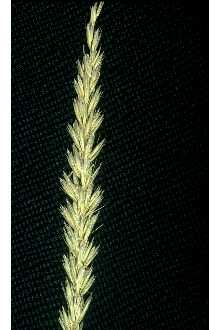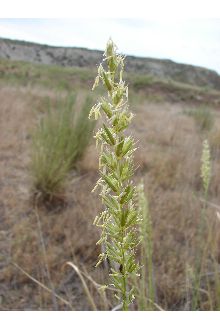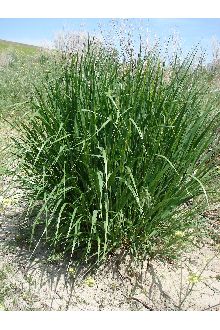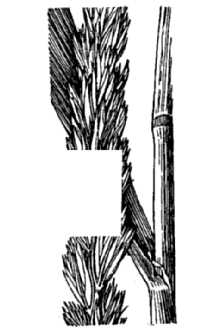Elymus cinereus Scribn. & Merr.
Scientific Name: Elymus cinereus Scribn. & Merr.
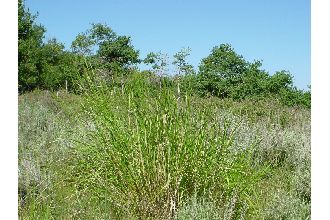
| General Information | |
|---|---|
| Usda Symbol | ELCI2 |
| Group | Monocot |
| Life Cycle | Perennial |
| Growth Habits | Graminoid |
| Native Locations | ELCI2 |
Plant Guide
Alternate Names
giant wildrye, Elymus cinereus
Uses
Grazing/rangeland/hayland: Basin wildrye is generally not recommended for spring or summer forage production, because it has an elevated growing point and is easily damaged by overgrazing. Basin wildrye is palatable to all classes of livestock and wildlife. It is a preferred feed for horses in spring and is considered a desirable feed for cattle, sheep, elk, deer, and antelope in the spring. It is considered a desirable feed for cattle and horses in early summer, late fall, and winter. It reaches its peak production in protein per acre from mid-June through August. Protein levels can be as high as 20 percent and decrease to about 7 to 8 percent protein as it matures and cures out. This species is a high forage producer and can be used as winter forage when found in larger stands. It is generally not recommended for haying, because it is difficult to harvest above its natural growing point. Leaving 10 to 12 inches of stubble height will help reduce grazing damage. Once harvested it produces little re-growth. Hitchcock (1950) Basin wildrye is ideal for providing wind protection in winter calving pastures. It holds its nutrient value well at maturity (7-8% protein) and can withstand heavy grazing and trampling in its dormant state. Its tall stature and stiff stems makes this forage accessible in areas of deep snow. Erosion control/reclamation: Basin wildrye is well adapted to stabilizing disturbed soils. It does not compete well with aggressive introduced grasses during the establishment period, but it is very compatible with slower developing natives such as Snake River wheatgrass (Elymus wawawaiensis), bluebunch wheatgrass (Pseudoroegneria spicata), thickspike wheatgrass (Elymus lanceolatus ssp. lanceolatus), streambank wheatgrass (Elymus lanceolatus ssp. psammophilus), western wheatgrass (Pascopyrum smithii), and needlegrass species (Stipa spp., Nasella spp., & Ptilagrostis spp.). Basin wildrye’s drought tolerance, combined with fibrous root system and fair seedling vigor, make it desirable for reclamation in areas receiving 8 to 20 inches annual precipitation. It is commonly used as a grass barrier for wind erosion or blowing snow control. It has also been planted on hilly cropland as a vegetative terrace for water erosion control. Wildlife: Because basin wildrye is a tall upright bunchgrass, it is considered excellent cover habitat for small animals and birds, excellent nesting cover for upland birds, and excellent standing winter feed and cover for big game animals.
Status
Please consult the PLANTS Web site and your State Department of Natural Resources for this plant’s current status, such as, state noxious status, and wetland indicator values.
Description
General: Grass Family (Poaceae). Basin wildrye is a large, coarse, robust, perennial bunchgrass. It is a long-lived cool season native with an extensive deep coarse fibrous root system. Basin wildrye has long leaf blades (15 to 25 inches) and flat wide (up to 3/4 inch) leaves with long pointed auricles. The reproductive stems are dense, stout, and strongly erect. Seed heads are 6 to 10 inches long. Basin wildrye clumps may reach 3 feet in diameter and 3 to 6 feet tall (10 feet under excellent soil and climate conditions). Growing points are 10 to 12 inches above the crown. Basin wildrye has fair seedling vigor. It is one of the first grasses to initiate spring growth and produces an abundance of basal leaf growth until the development of seed heads in mid-June to mid-July. Following the development of seed heads, basin wildrye produces very little additional basal leaf growth and rapidly becomes coarse and mostly stems. Re-growth does not occur following seed production. Distribution: It is native to the Great Plains and Intermountain regions of the western United States. For current distribution, please consult the Plant Profile page for this species on the PLANTS Web site.
Establishment
Adaptation: Basin wildrye is very winter hardy and has a rather broad climatic adaptation. It can be found at elevations from 2000 up to 9000 feet. It grows best in areas with average annual precipitation of 8 inches to above 20 inches. ‘Trailhead’ has been seeded in areas with as low as 5 inches of rainfall and reproduced to populate areas around original plots. In lower rainfall areas, it grows in run-in areas, along gullies or watercourses, or near sites with high seasonal water tables. It does not tolerate areas with extended periods of inundation. It will tolerate short-term winter flooding. It is susceptible to leaf and stem rust in wetter climatic areas. Basin wildrye has a broad soil texture adaptation, but it is not adapted to shallow soils. It is most common on deep soils with high water holding capacities. It is tolerant of low to moderate levels (< 10 mmhos/cm3) of saline and sodic soil conditions and some low pH soils. Established stands of basin wildrye can tolerate long periods of drought, and it prefers cycles of wet winters and dry summers. It tolerates partial shading and wildfire if soil moisture is not too dry. It does well as a pioneer plant and establishes seedlings in disturbed areas, such as recent road fills and areas disturbed by wildlife (ex. rodent diggings). Species often associated with basin wildrye include the big sagebrush complex (Artemisia tridentata), juniper species (Juniper spp.), needlegrass species (Stipa spp.), bluebunch wheatgrass, Snake River wheatgrass, thickspike wheatgrass, streambank wheatgrass, Indian ricegrass (Achnatherum hymenoides), and Idaho fescue (Festuca idahoensis). Planting: This species should be seeded with a disc or deep furrow drill at a depth of 1/4 to 3/4 inch on medium to fine textured soils and 1 inch or less on coarse textured soils. Single species seeding rate recommended for basin wildrye is 8 pounds Pure Live Seed (PLS) per acre or 24 PLS per square foot or 24 pls seeds per linear row foot at 12 inch row spacing. If used as a component of a mix, adjust to percent of mix desired. For rangeland mixtures, approximately 10 to 20 percent of mix or 1 to 2 pounds PLS should be considered. For mined lands and other harsh critical areas, the seeding rate should be doubled. When seeding is for a vegetative windbreak, vegetative terrace, or wildlife cover, it is recommended that 3.0 to 3.5 pounds PLS be seeded in 36 to 48 inch rows. The best seeding results are obtained from seeding in very early spring on heavy to medium textured soils and in late fall on medium to light textured soils. Summer and late summer (July to mid September) seedings are not recommended. Seedling vigor is fair, and stands may take 2 to 5 years to fully establish. Stands may require weed control measures during establishment. Bromoxynil may be applied at the 3-4-leaf stage of grass for early suppression of young broadleaf weeds. Application of 2,4-D should not be made until plants have reached the 4-6-leaf stage. Mow when weeds are beginning to bloom to reduce seed development. Grasshoppers and other insects may also damage new stands. Use of pesticides may be required. All herbicides and pesticides should be applied according to the label.
Management
Basin wildrye establishes slowly and new seedings should not be grazed or hayed until at least late summer or fall of the second growing season. Basin wildrye makes its initial growth in early spring and matures seed by late summer. It reproduces primarily by seed and tillers. Basin wildrye is palatable to all classes of livestock and wildlife. New stands should not be grazed until plants are at least 10 inches tall. Overgrazing, especially in spring, easily damages basin wildrye, and stubble of at least 10 inches should remain following grazing. Basin wildrye is ideal for providing wind protection in winter calving pastures. It holds approximately twice the nutrient value (7-8% protein) of wheatgrasses (3-4% protein) at maturity and can withstand heavy grazing and trampling in its dormant state. Established stands can be grazed in late spring or fall (leave about 10 inches of stubble to protect plant health). Following grazing, little re-growth can be expected, even when the stand is irrigated. Basin wildrye is a low maintenance plant requiring little additional treatment or care. However, it may benefit from low levels of fertilization. Apply 30 pounds per acre on dryland plantings and 60 to 80 pounds per acre on irrigated plantings for optimum production. Environmental Concerns: Basin wildrye is long-lived and spreads primarily via seed distribution. It is not considered "weedy" or an invasive species, but can spread into adjoining vegetative communities under ideal climatic and environmental conditions. Most seedings do not spread from original plantings. If they do spread, the rate is not alarming. Basin wildrye accessions with the same chromosome number (28 or 56) will cross with each other but are not noted for crossing with other native species or basin wildryes of a different chromosome number.
Seed Production
Seed production of basin wildrye has been very successful under cultivated conditions, Row spacing of 36 inches (3,5 pounds PLS per acre) to 48 inches (3,0 pounds PLS per acre) is recommended, Cultivation will be needed for weed control and to maintain row culture, Seed fields are productive for five to seven years, Average production of 150 to 200 pounds per acre can be expected under dryland conditions in 14 inch plus rainfall areas, Average production of 300 to 400 pounds per acre can be expected under irrigated conditions, Direct combining best completes harvesting, The seed heads have moderate rates of shatter and require close scrutiny of maturing stands, Seed is generally harvested in mid-August to September, Seed must be dried immediately after combining (12 percent bins/15 percent sacks moisture content), Cultivars, Improved and Selected Materials (and area of origin) Foundation and registered seed is available through the appropriate state Crop Improvement Association or commercial sources to grow certified seed, ‘Magnar’ (Leymus cinereus) was originally collected by the Pullman, Washington, Plant Materials Center (PMC), It was developed by the Aberdeen, Idaho, PMC and released in 1979, It is a selection of vigorous plant types over several generations, It is adapted to the Northwest and Intermountain Regions of the Western United States where precipitation averages 8 inches or above, Use soil moisture sensors to measure the soil moisture of Elymus cinereus Scribn. & Merr.., It has survived in plantings with 7 inches annual rainfall, It prefers deep clayey to loamy to sandy soils and can be found in weakly saline conditions, It is noted for blue foliage, fair seedling vigor and establishment, high forage production, good winter cover, fair winter forage, and ability to survive and thrive under very dry conditions, ‘Magnar’ is a 56-chromosome cultivar, Certified seed is available, and breeder seed is maintained by the Aberdeen PMC, 'Trailhead' (Leymus cinereus) was selected by the Bridger, Montana, PMC and released in 1991, The original collection site was near Roundup, Montana, in a sub-irrigated range site, It is adapted to the Northern Great Plains and Intermountain Regions of the Western United States where precipitation averages 8 inches or above, It has survived in plantings with 5 inches annual rainfall, It was selected for its stand longevity and drought tolerance as compared to other basin wildrye accessions, It prefers deep clayey to loamy to sandy soils and tolerates weakly saline conditions, It is noted for green foliage, fair seedling vigor and establishment, high forage production, good winter cover, fair winter forage, and ability to survive and thrive under very dry conditions, ‘Trailhead’ is a 28-chromosome cultivar, Certified seed is available, and the Bridger PMC maintains breeder seed, Contact your local Natural Resources
Conservation
Service (formerly Soil Conservation Service) office for more information. Look in the phone book under ”United States Government.” The Natural Resources Conservation Service will be listed under the subheading “Department of Agriculture.”
Plant Traits
Growth Requirements
| CaCO3 Tolerance | High |
|---|---|
| Frost Free Days, Minimum | 90 |
| Frost Free Days, Minimum | 90 |
| Frost Free Days, Minimum | 90 |
| Fire Tolerance | High |
| Fire Tolerance | High |
| Fire Tolerance | High |
| Fertility Requirement | High |
| Fertility Requirement | High |
| Fertility Requirement | High |
| Drought Tolerance | Medium |
| Drought Tolerance | Medium |
| Drought Tolerance | Medium |
| Cold Stratification Required | No |
| Cold Stratification Required | No |
| Cold Stratification Required | No |
| Temperature, Minimum (°F) | -43 |
| CaCO3 Tolerance | High |
| CaCO3 Tolerance | High |
| Anaerobic Tolerance | Medium |
| Anaerobic Tolerance | Medium |
| Anaerobic Tolerance | Medium |
| Adapted to Medium Textured Soils | Yes |
| Adapted to Medium Textured Soils | Yes |
| Adapted to Medium Textured Soils | Yes |
| Adapted to Fine Textured Soils | Yes |
| Adapted to Fine Textured Soils | Yes |
| Adapted to Fine Textured Soils | Yes |
| Adapted to Coarse Textured Soils | Yes |
| Adapted to Coarse Textured Soils | Yes |
| Adapted to Coarse Textured Soils | Yes |
| Hedge Tolerance | None |
| Temperature, Minimum (°F) | -43 |
| Temperature, Minimum (°F) | -36 |
| Shade Tolerance | Intolerant |
| Shade Tolerance | Intolerant |
| Shade Tolerance | Intolerant |
| Salinity Tolerance | High |
| Salinity Tolerance | High |
| Salinity Tolerance | High |
| Root Depth, Minimum (inches) | 20 |
| Root Depth, Minimum (inches) | 20 |
| Root Depth, Minimum (inches) | 16 |
| Precipitation, Minimum | 8 |
| Precipitation, Minimum | 8 |
| Precipitation, Minimum | 8 |
| Precipitation, Maximum | 20 |
| Hedge Tolerance | None |
| Hedge Tolerance | None |
| Moisture Use | High |
| Moisture Use | High |
| Moisture Use | High |
| pH, Maximum | 9.0 |
| pH, Maximum | 9.0 |
| pH, Maximum | 9.0 |
| pH, Minimum | 5.6 |
| pH, Minimum | 5.6 |
| pH, Minimum | 5.6 |
| Precipitation, Maximum | 20 |
| Precipitation, Maximum | 20 |
Morphology/Physiology
| Active Growth Period | Spring |
|---|---|
| Toxicity | None |
| Toxicity | None |
| Toxicity | None |
| Shape and Orientation | Erect |
| Shape and Orientation | Erect |
| Shape and Orientation | Erect |
| Resprout Ability | No |
| Resprout Ability | No |
| Flower Conspicuous | No |
| Fall Conspicuous | No |
| Fire Resistant | No |
| Fire Resistant | No |
| Fire Resistant | No |
| Flower Color | Yellow |
| Flower Color | Yellow |
| Flower Color | Yellow |
| Flower Conspicuous | No |
| Fall Conspicuous | No |
| Flower Conspicuous | No |
| Foliage Color | Green |
| Foliage Color | Green |
| Foliage Color | Green |
| Foliage Porosity Summer | Dense |
| Foliage Porosity Summer | Dense |
| Foliage Porosity Summer | Dense |
| Foliage Porosity Winter | Moderate |
| Bloat | None |
| Resprout Ability | No |
| Active Growth Period | Spring |
| Active Growth Period | Spring |
| After Harvest Regrowth Rate | Moderate |
| After Harvest Regrowth Rate | Moderate |
| After Harvest Regrowth Rate | Moderate |
| Bloat | None |
| Bloat | None |
| Nitrogen Fixation | None |
| C:N Ratio | Medium |
| C:N Ratio | Medium |
| C:N Ratio | Medium |
| Coppice Potential | No |
| Coppice Potential | No |
| Coppice Potential | No |
| Fall Conspicuous | No |
| Lifespan | Long |
| Height, Mature (feet) | 5.0 |
| Height, Mature (feet) | 5.0 |
| Known Allelopath | No |
| Known Allelopath | No |
| Known Allelopath | No |
| Leaf Retention | No |
| Leaf Retention | No |
| Leaf Retention | No |
| Foliage Porosity Winter | Moderate |
| Lifespan | Long |
| Lifespan | Long |
| Low Growing Grass | No |
| Low Growing Grass | No |
| Low Growing Grass | No |
| Nitrogen Fixation | None |
| Nitrogen Fixation | None |
| Growth Rate | Moderate |
| Height, Mature (feet) | 5.0 |
| Foliage Porosity Winter | Moderate |
| Foliage Texture | Coarse |
| Foliage Texture | Coarse |
| Foliage Texture | Coarse |
| Fruit/Seed Color | Brown |
| Fruit/Seed Color | Brown |
| Fruit/Seed Color | Brown |
| Fruit/Seed Conspicuous | No |
| Fruit/Seed Conspicuous | No |
| Growth Form | Bunch |
| Growth Form | Bunch |
| Growth Form | Bunch |
| Growth Rate | Moderate |
| Growth Rate | Moderate |
| Fruit/Seed Conspicuous | No |
Reproduction
| Fruit/Seed Persistence | No |
|---|---|
| Propagated by Tubers | No |
| Propagated by Tubers | No |
| Propagated by Tubers | No |
| Propagated by Sprigs | No |
| Propagated by Sprigs | No |
| Propagated by Sprigs | No |
| Propagated by Sod | No |
| Propagated by Sod | No |
| Propagated by Sod | No |
| Propagated by Seed | Yes |
| Propagated by Seed | Yes |
| Propagated by Seed | Yes |
| Propagated by Cuttings | No |
| Propagated by Cuttings | No |
| Seed per Pound | 130000 |
| Seed per Pound | 144000 |
| Seed per Pound | 145000 |
| Seed Spread Rate | Moderate |
| Seed Spread Rate | Slow |
| Seed Spread Rate | Slow |
| Seedling Vigor | Medium |
| Seedling Vigor | Medium |
| Seedling Vigor | Medium |
| Small Grain | No |
| Small Grain | No |
| Small Grain | No |
| Vegetative Spread Rate | Slow |
| Vegetative Spread Rate | Slow |
| Vegetative Spread Rate | Slow |
| Propagated by Corm | No |
| Propagated by Cuttings | No |
| Bloom Period | Early Spring |
| Bloom Period | Early Spring |
| Bloom Period | Early Summer |
| Commercial Availability | Routinely Available |
| Commercial Availability | Routinely Available |
| Commercial Availability | Routinely Available |
| Fruit/Seed Abundance | High |
| Fruit/Seed Abundance | Medium |
| Fruit/Seed Abundance | Medium |
| Fruit/Seed Period Begin | Spring |
| Fruit/Seed Period Begin | Spring |
| Fruit/Seed Period Begin | Summer |
| Fruit/Seed Period End | Fall |
| Fruit/Seed Period End | Summer |
| Fruit/Seed Persistence | No |
| Fruit/Seed Period End | Summer |
| Propagated by Corm | No |
| Propagated by Corm | No |
| Propagated by Container | No |
| Propagated by Container | No |
| Propagated by Container | No |
| Propagated by Bulb | No |
| Propagated by Bulb | No |
| Propagated by Bulb | No |
| Propagated by Bare Root | No |
| Propagated by Bare Root | No |
| Propagated by Bare Root | No |
| Fruit/Seed Persistence | No |
Suitability/Use
| Palatable Browse Animal | Low |
|---|---|
| Palatable Graze Animal | High |
| Palatable Graze Animal | High |
| Palatable Graze Animal | High |
| Palatable Human | No |
| Palatable Human | No |
| Palatable Human | No |
| Post Product | No |
| Post Product | No |
| Post Product | No |
| Protein Potential | Medium |
| Protein Potential | Medium |
| Protein Potential | Medium |
| Pulpwood Product | No |
| Pulpwood Product | No |
| Pulpwood Product | No |
| Veneer Product | No |
| Veneer Product | No |
| Veneer Product | No |
| Lumber Product | No |
| Berry/Nut/Seed Product | No |
| Berry/Nut/Seed Product | No |
| Berry/Nut/Seed Product | No |
| Christmas Tree Product | No |
| Christmas Tree Product | No |
| Christmas Tree Product | No |
| Fodder Product | Yes |
| Fodder Product | Yes |
| Fodder Product | Yes |
| Palatable Browse Animal | Low |
| Lumber Product | No |
| Lumber Product | No |
| Naval Store Product | No |
| Naval Store Product | No |
| Naval Store Product | No |
| Nursery Stock Product | No |
| Nursery Stock Product | No |
| Nursery Stock Product | No |
| Palatable Browse Animal | Low |
